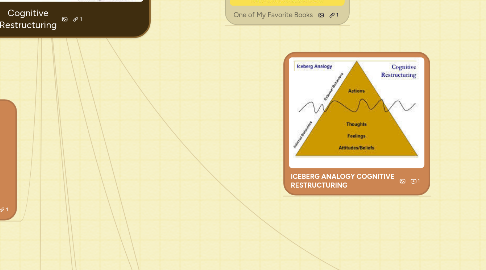
1. Where I wanted to be at My Age...
1.1. When did you first conceptualize of what you wanted to be when you got older?
1.2. Did you have a hero, or mentor who inspired you? Who was it?
1.3. Make a list of things you wanted to do by your age now.
1.4. Think about the things you have accomplished that you never thought you could. Write them down, too.
1.5. If you could start over now, what would you do differently?
1.6. What would help you to meet your goals now?
1.7. Who do you know who met this goal, and what did they do to accomplish it?
2. This is an informal introduction to cognitive restructuring that I created for friends; there are some good resources here, though, and some helpful links. This is some of what I remember from my study of psychology/behavioral psychology at Portland State University. I am sending over some journal articles and a book suggestion or two-- in case you would like to read a little more. Generally speaking, any positive behaviors you can engage in during stress can be helpful in breaking up negative patterns. These include activities like walking, dancing, talking to a friend, gardening, or planning a home-design or other creative project. I hope it helps you.
3. It takes about 21 days to change a behavior. To change a behavior, take a week-long baseline, see how often you do the behavior, and make a plan to stop or change it. You can keep a behavior journal. Look for "allies for change" in your life who you can share your plan with.
4. Every time you interrupt a negative thought-- you decrease stress and decrease the likelihood of stress-related diseases.
5. Wikipedia Says...
6. Another Good Book:
7. Anxiety
7.1. What are you saying to yourself?
7.1.1. Write it down in a journal...
7.1.2. Think of all of the times similar situations have worked better, and write down what happened...
7.1.2.1. Take your feelings seriously, if you don't feel safe, don't try to talk yourself out of it-- go and get a second opinion from a colleague or friend on the situation you are worried about.
7.1.2.2. On the same subject, challenge your anxieties to prove themselves. Is it really likely that what your afraid of will happen the way you think?
7.1.2.3. I was listening to TV earlier and I heard someone say that 85% of the things we catastophize about don't come to pass.
7.1.2.4. Is anyone you know currently challenging themselves to meet the goal you have set for yourself? Be their friend, and ask to join them on their quest. When you have met that goal, set another one! Start a goal-challenger's club!
7.1.3. Find someone to talk to about why this situation is different...
7.1.4. Change negative self talk to positive
7.1.4.1. Change the statement to include positive possibilities.
7.1.4.2. Example: Negative-- "I'll never get to be on Jeopardy. I don't look good enough for TV."
7.1.4.2.1. Practice converting negative self-talk statements into positive ones that empower you to take action. This interrupts negative self-statements that can become ingrained. Our habits and stress patterns reflect them.
7.1.4.2.2. Are you experiencing irrational beliefs?
7.1.4.2.3. Example: Positive-- "I might not be ready for Vanna now, but watch out in a year! My friends and I are going to the Jeopardy show in style; we're going to go to the gym. I'm buying a membership. Ahhh, that jaccuzi is going to feel so good...
7.1.4.3. This allows you to focus on positive opportunities for meeting your goals the way you can meet them now-- not as the person you were ten years ago when you first had the idea.
7.1.5. Think about what you wanted from this situation:
7.1.5.1. Is there another way to bring what you want into your life?
7.1.5.2. Who do you know who has overcome obstacles similar to your own?
7.1.5.3. How did they do it?
7.1.5.4. Create a positive dialogue with a mentor in your imagination that focuses on what you tried to do, and what you wanted from the situation...
7.2. Has this situation ever worked out differently that what you are expecting before?
7.2.1. What do you believe about this situation?
7.2.1.1. Think about the origins fo the belief; does it still apply to you?
7.2.1.2. What was your social location at the time you adopted this belief? Do you still fit within that context?
7.2.1.3. What has changed? What hasn't
7.3. Could this have worked this time?
7.3.1. Write down what made this situation work in the past.
7.3.2. Compare the two; What was different?
7.3.3. What made the situation work better?

